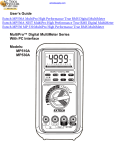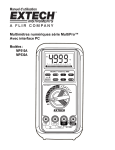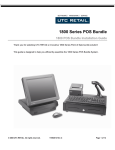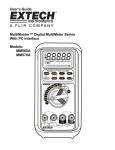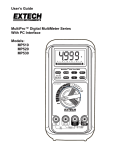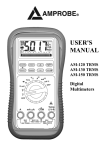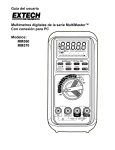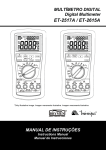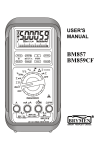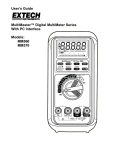Download Extech Instruments MP530 User`s guide
Transcript
User’s Guide MultiPro™ Digital MultiMeter Series With PC Interface Models: MP510A MP530A 00 1 21 3 42 5 63 A 7 84 9 105 2 1) SAFETY Terms in this manual WARNING identifies conditions and actions that could result in serious injury or even death to the user. CAUTION identifies conditions and actions that could cause damage or malfunction in the instrument. This manual contains information and warnings that must be followed for operating the instrument safely and maintaining the instrument in a safe operating condition. If the instrument is used in a manner not specified by the manufacturer, the protection provided by the instrument may be impaired. The meter is intended only for indoor use. The meter protection rating, against the users, is double insulation per IEC61010-1 2nd Ed., EN61010-1 2nd Ed., UL61010-1 2nd Ed. and CAN/CSA C22.2 No. 61010.1-0.92 to Category III 1000 Volts AC & DC and Category IV 600 Volts AC & DC. Terminals (to COM) measurement category: V / A / mAμA : Category III 1000 Volts AC & DC, and Category IV 600 Volts AC & DC. Per IEC61010-1 2nd Ed. (2001) Measurement Category Measurement Category IV (CAT IV) is for measurements performed at the source of the low-voltage installation. Examples are electricity meters and measurements on primary overcurrent protection devices and ripple control units. Measurement Category III (CAT III) is for measurements performed in the building installation. Examples are measurements on distribution boards, circuit- breakers, wiring, including cables, bus-bars, junction boxes, switches, socket-outlets in the fixed installation, and equipment for industrial use and some other equipment, for example, stationary motors with permanent connection to the fixed installation. Measurement Category II (CAT II) is for measurements performed on circuits directly connected to the low voltage installation. Examples are measurements on household appliances, portable tools and similar equipment. 3 WARNING To reduce the risk of fire or electric shock, do not expose this product to rain or moisture. To avoid electrical shock hazard, observe the proper safety precautions when working with voltages above 60 VDC or 30 VAC rms. These voltage levels pose a potential shock hazard to the user. Do not touch test lead tips or the circuit being tested while power is applied to the circuit being measured. Keep your fingers behind the finger guards of the test leads during measurement. Inspect test leads, connectors, and probes for damaged insulation or exposed metal before using the instrument. If any defects are found, replace them immediately. Do not measure any current that exceeds the current rating of the protection fuse. Do not attempt a current measurement to any circuit where the open circuit voltage is above the protection fuse voltage rating. Suspected open circuit voltage should be checked with voltage functions. Never attempt a voltage measurement with the test lead inserted into the μA/mA or A input jack. Only replace the blown fuse with the proper rating as specified in this manual. CAUTION Disconnect the test leads from the test points before changing functions. Always set the instrument to the highest range and work downward for an unknown value when using manual ranging mode. INTERNATIONAL ELECTRICAL SYMBOLS Caution ! Refer to the explanation in this Manual ! Caution ! Risk of electric shock Earth (Ground) Double Insulation or Reinforced insulation Fuse AC--Alternating Current DC--Direct Current 2) CENELEC DIRECTIVES The instruments conform to CENELEC Low-voltage directive 2006/95/EC and Electromagnetic compatibility directive 2004/108/EC 4 3) PRODUCT DESCRIPTION Panel Illustration 1) 5000 count LCD display 1 00 1 21 3 42 5 63 7 84 9 105 2 A 3 4 5 6 7 2) Push-buttons for special functions & features 3) Selector to turn the Power On or Off and Select a function 4) Input Jack for 10A (20A for 30sec) current function 5) Input Jack for all functions EXCEPT current (μA, mA, A) functions 6) Common (Ground reference) Input Jack for all functions 7) Input Jack for milli-amp and micro-amp current functions 5 Analog bar-graph The analog bar graph provides a visual indication of measurement like a traditional analog meter needle. It is excellent for detecting faulty contacts, identifying potentiometer clicks, and indicating signal spikes during adjustments. Average sensing RMS calibrated RMS (Root-Mean-Square) is the term used to describe the effective or equivalent DC value of an AC signal. Most digital multimeters use average sensing RMS calibrated technique to measure RMS values of AC signals. This technique is to obtain the average value by rectifying and filtering the AC signal. The average value is then scaled upward (calibrated) to read the RMS value of a sine wave. In measuring pure sinusoidal waveforms, this technique is fast, accurate and cost effective. In measuring non-sinusoidal waveforms, however, significant errors can be introduced because of different scaling factors relating average to RMS values. True RMS True RMS is a term which identifies a DMM that responds accurately to the effective RMS value regardless of the waveforms such as: square, sawtooth, triangle, pulse trains, spikes, as well as distorted waveforms with the presence of harmonics. Harmonics may cause : 1)Overheating in transformers, generators and motors 2)Circuit breakers to trip prematurely 3)Fuses to blow 4)Neutrals to overheat due to the triplen harmonics present on the neutral 5)Bus bars and electrical panels to vibrate Crest Factor Crest Factor is the ratio of the Crest (instantaneous peak) value to the True RMS value, and is commonly used to define the dynamic range of a True RMS DMM. A pure sinusoidal waveform has a Crest Factor of 1.4. A badly distorted sinusoidal waveform normally has a much higher Crest Factor. NMRR (Normal Mode Rejection Ratio) NMRR is the DMM's ability to reject unwanted AC noise effects that can cause inaccurate DC measurements. NMRR is typically specified in terms of dB (decibel). This series has a NMRR specification of >60dB at 50 and 60Hz, which means a good ability to reject the effect of AC noise in DC measurements. 6 CMRR (Common Mode Rejection Ratio) Common mode voltage is voltage present on both the COM and VOLTAGE input terminals of a DMM, with respect to ground. CMRR is the DMM's ability to reject common mode voltage effect that can cause digit rolling or offset in voltage measurements. This series has a CMRR specification of >60dB at DC to 60Hz in ACV function; and >120dB at DC, 50 and 60Hz in DCV function. If neither NMRR nor CMRR specification is specified, a DMM's performance will be uncertain. 4) OPERATION CAUTION Before and after hazardous voltage measurements, test the voltage function on a known source such as line voltage to determine proper meter functioning. DC Voltage, AC Voltage, & Hz Frequency functions mV function defaults at DC. Press SELECT button momentarily to select AC. Press the Hz push-button momentarily to activate or to exit Hz. DCV A ACV A Hz A Note: Input sensitivity varies automatically with function range selected before activating the Hz function. mV function has the highest (300mV) and the 1000V range has the lowest (300V). It is recommended to first measure the signal voltage (or current) level then activate the Hz function in that voltage (or current) range to automatically set the most appropriate trigger level. You can also press the RANGE button momentarily to select another trigger level manually. If the Hz reading becomes unstable, select lower sensitivity to avoid electrical noise. If the reading shows zero, select higher sensitivity. Capacitance, Diode test function Default at . Press SELECT button momentarily to select 7 Diode test function. CAUTION Discharge capacitors before making any measurement. Large value capacitors should be discharged through an appropriate resistance load. Cap A Diode A Forward Bias Diode A Reverse Bias Normal forward voltage drop (forward biased) for a good silicon diode is between 0.400V to 0.900V. A higher reading indicates a leaky diode (defective). A zero reading indicates a shorted diode (defective). An OL indicates an open diode (defective). Reverse the test leads connections (reverse biased) across the diode. The digital display shows OL if the diode is good. Any other readings indicate the diode is resistive or shorted (defective). 8 Temperature function (Model MP530 only) Press SELECT button momentarily to toggle between °C and °F readings, and the new setting will be saved automatically in the non-volatile memory as power up default. K-temp A K-temp A Note: Be sure to insert the banana plug K-type temperature bead probe with correct polarities. Ω Resistance, Continuity functions Default at Ω. Press SELECT button momentarily to select Continuity function, convenient for checking wiring connections and operation of switches. A continuous beep tone indicates a complete wire. A A 9 CAUTION Using resistance and continuity function in a live circuit will produce false results and may damage the instrument. In many cases the suspected component must be disconnected from the circuit to obtain an accurate reading Ω Ω A A 3 Sec Auto leads resistance calibration When entering the 50Ω range manually by RANGE button for high precision low resistance measurement, this feature will prompt to short the inputs for calibration. The display shows “Shrt”. Simply short the leads for 3 seconds until the display shows zero, then the resistance in the leads and in the internal protection circuitry of the meter is compensated automatically. The compensation value can be as much as 5Ω. If a compensation value that is higher than that is needed, Relative mode is recommended. The shortcut is to short the test leads in auto-ranging resistance mode until the meter enters the lowest 50Ω range automatically, press the RANGE button momentarily to get the “Shrt” prompt, then wait 3 more seconds until the display shows zero. Note: The calibration stays until the range is changed, the function is changed, or autoranging mode is selected. 10 μA, mA, and A Current functions Default at DC. Press SELECT button momentarily to select AC. *Note: When measuring a 3-phase system, special attention should be taken to the phase-to-phase voltage which is significantly higher than the phase-to-earth voltage. To avoid exceeding the voltage rating of the protection fuse(s) accidentally, always consider the phase-to-phase voltage as the working voltage for the protection fuse(s). A A PC-COMM computer interface capabilities The instruments are equipped with an optical isolated interface port at the meter back for data communication. An optional PC interface kit is required to connect the meter to the PC computer. 11 50ms MAX/MIN at fast 20/s measurement mode (Model MP530 only) Press the MAX/MIN button momentarily to activate MAX/MIN recording mode. The LCD annunciators “MAX MIN” turn on, and the reading update rate will be increased to 20/second. The meter beeps when a new maximum or minimum reading is updated. Press the button momentarily to read throughout the Maximum (MAX), Minimum (MIN), and Maximum minus Minimum (MAX-MIN) readings. Press the button for greater than 1 second exit MAX/MIN mode. Auto Power Off feature will be automatically disabled in this mode. 0.8ms PEAK capture mode (Model MP530 only) Press PEAK button momentarily to activate Instantaneous Peak-Hold mode to capture voltage or current signal duration as short as 0.8ms. This mode is available in DCV, ACV, DCA, & ACA functions. The LCD annunciators “C” & “MAX” turn on. The meter beeps when a new maximum or minimum reading is updated. Press the button momentarily to read throughout the Maximum (MAX), Minimum (MIN), and Maximum minus Minimum (MAX-MIN) readings. Press the button for greater than 1 second to exit PEAK capture mode. Auto Power Off feature will be disabled automatically in this mode. 12 Backlighted display Press the SELECT button for 1 second or more to turn on or off the display backlight function. The backlight will also be turned off automatically after 30 seconds to extend battery life. Hold The hold function freezes the display for later viewing. Press the HOLD momentarily to activate or to exit the hold function button Zoom 5x analog pointer (Model MP530 only) The Zoom mode analog pointer magnifies up to 5 times the regular analog bar graph resolution to show minute signal changes with a single analog pointer. It is virtually equivalent to the bar graph resolution of 5 X 50 = 250 segments. 13 Relative mode (Model MP530 only) Relative zero allows any reading to be stored as a reference value and all following reading to be reference to that value. Practically all displaying readings can be set as relative reference value including MAX/MIN feature readings. Press the button momentarily to activate and to exit relative zero mode. Manual or Auto-ranging Press the RANGE button momentarily to select manual-ranging, and the meter will remain in the selected range and the LCD annunciator will turn off. Press the button momentarily again to step through the ranges. Press and hold the button for greater than 1 second to resume auto-ranging. Note: Manual ranging feature is not available in Hz function. Beep-Jack™ Input Warning The meter beeps as well as displays “InEr” to warn the user against possible damage to the meter due to improper connections to the μA, mA, or A input jacks when other function (such as the voltage function) is selected. Set Beeper Off Press the Hz button while turning the meter on to disable the Beeper feature. 14 Auto Power Off (APO) The Auto Power Off (APO) mode turns the meter off automatically to extend battery life after approximately 17 minutes of no activity. Activities are specified as: 1) Rotary switch or push button operations, and 2) Significant measuring readings of above 10% of range or non-OL Ω readings. That is, the meter will intelligently avoid entering the APO mode when it is under normal measurements. To wake up the meter from APO, press the SELECT button momentarily or turn the rotary switch to the OFF position and then turn back on again. Always turn the rotary switch to the OFF position when the meter is not in use Disabling Auto Power Off Press the RANGE button while turning the meter on to disable the Auto Power Off (APO) feature. 5) MAINTENANCE WARNING To avoid electrical shock, disconnect the meter from any circuit, remove the test leads from the input jacks and turn OFF the meter before opening the case. Do not operate with open case. Install only the same type of fuse or equivalent Turn-On diagnostics If self-diagnostic message “rE-O” is displayed while powering on the meter, do not switch off the meter off. The meter will quickly complete the task and return to normal operation. However, if self-diagnostic message “C_Er” is displayed while powering on, some meter ranges may be significantly out of specification. To avoid measurement errors, stop using the meter and send it in for re-calibration. Refer to the WARRANTY section for obtaining warranty or repair service. Cleaning and Storage Periodically wipe the case with a damp cloth and mild detergent; do not use abrasives or solvents. If the meter is not to be used for periods longer than 60 days, remove the battery and store it separately 15 Trouble Shooting If the instrument fails to operate, check battery, fuses, leads, etc., and replace as necessary. Double check operating procedure as described in this user’s manual If the instrument voltage-resistance input terminal is subjected to accidental high voltage transient the series fusible resistors will blow (become high impedance), like standard fuses, to protect the user and the instrument. Most measuring functions through this terminal will then be an open circuit. The series fusible resistors and the spark gaps should only be replaced by qualified technician. Refer to the WARRANTY section for obtaining warranty or repairing service. Battery and Fuse replacement Battery use: Single 9V battery NEDA1604, JIS006P or IEC6F22; or 9V alkaline battery NEDA1604A, JIS6AM6 or IEC6LF22 Fuses: Fuse (FS1) for μAmA current input: 0.44A/1000V, IR 10kA or better, F fuse Fuse (FS2) for A current input: 11A/1000V, IR 20kA or better, F fuse Battery replacement for models with battery access door: Loosen the 2 screws from the battery access door of the case bottom. Lift the battery access door and thus the battery compartment up. Replace the battery. Re-fasten the screws. Fuse replacement (and also Battery replacement for splash proof version without battery access door): Loosen the 4 screws from the case bottom. Lift the end of the case bottom nearest the input jacks until it unsnaps from the case top. Replace the blown fuse(s) and/or the battery. Replace the case bottom, and ensure that all the gaskets are properly seated and the two snaps on the case top (near the LCD side) are engaged. Re-fasten the screws. (6) SPECIFICATIONS DC VOLTAGE RANGE Accuracy 50.00 mV 0.12% + 2d 500.0 mV 0.06% + 2d 5.000V, 50.00V, 500.0V, 1000V 0.08% + 2d NMRR: >60dB @ 50/60Hz, CMRR: >120dB @ DC, 50/60Hz, Rs=1kΩ Input impedance: 10MΩ, 16pF nominal (44pF nominal for 50mV & 500mV ranges) AC VOLTAGE Accuracy RANGE 50Hz/60Hz 50.00mV, 500.0mV, 5.000V, 50.00V, 500.0V, 1000V 0.5% + 3d 40Hz to 500Hz 50.00mV, 500.0mV 0.8% + 3d 5.000V, 50.00V, 500.0V 1.0% + 4d 1000V 1.2% + 4d Up to 20kHz 50.00mV, 500.0mV 0.5dB* 5.000V, 50.00V, 500.0V 3dB* 1000V Unspecified *Specified from 30% to 100% of range CMRR: >60dB @ DC to 60Hz, Rs=1kΩ Input Impedance: 10MΩ, 16pF nominal (44pF nominal for 50mV & 500mV ranges) DC CURRENT RANGE Accuracy Burden Voltage 500.0μA, 5000μA 0.15mV/μA 0.2% + 4d 50.00mA, 500.0mA 3.3mV/mA 5.000A, 10.00A* 45mV/A *10A continuous, 20A for 30 seconds max with a 5 minute cool down interval 16 AC CURRENT RANGE Accuracy Burden Voltage 50 / 60Hz 0.6%+3d 500.0μA, 5000μA 0.15mV/μA 50.00mA, 500.0mA 0.6%+3d 3.3mV/mA 5.000A, 10.00A* 0.6%+3d 45mV/A 40Hz to 1kHz 0.8%+4d 500.0μA, 5000μA 0.15mV/μA 50.00mA 0.8%+4d 3.3mV/mA 500.0mA 1.0%+4d 3.3mV/mA 5.000A, 10.00A* 0.8%+4d 45mV/A *10A continuous, 20A for 30-second max with 5 minutes cool down interval Peak Capture (for V & A) Specified accuracy ±150 digits for changes > 5 ms in duration RESISTANCE RANGE Accuracy 0.3% + 6d 50.00Ω 0.1% + 3d 500.0Ω 0.1% + 2d 5.000kΩ, 50.00kΩ, 500.0kΩ 0.4% + 3d 5.000MΩ 2.0% + 5d 50.00MΩ Open Circuit Voltage: < 1.3VDC (< 3VDC for 50Ω & 500Ω ranges) CAPACITANCE RANGE Accuracy* 50.00nF, 500.0nF 0.8% + 3d 1.0% + 3d 5.000μF 2.0% + 3d 50.00μF 3.5% + 5d 500.0μF** 5.0% + 5d 9999μF** *Accuracies with film capacitor or better **In manual ranging mode, measurements are not specified below 45.0μF and 450μF for the 500.0μF and 9999μF ranges respectively 17 TEMPERATURE (MP530 ONLY) RANGE -50°C TO 1000°C -58°F TO 1832°F 18 Accuracy 0.3% + 3d 0.3% + 6d FREQUENCY Function Sensitivity Range (ACrms) mV 300mV 10Hz - 125kHz 5V 2V 10Hz - 125kHz 50V 20V 10Hz - 20kHz 500V 80V 10Hz - 1kHz 1000V 300V 10Hz - 1kHz 300mV 10Hz - 125kHz Ω, Cx, diode 10% F.S. 10Hz - 125kHz μA, mA, A Peak mode for V & A functions Accuracy: Specified accuracy ±150 digits for changes > 0.8 ms in duration Audible Continuity: Measurement threshold: Beeper will sound if measurement is below 20 . Beeper will not sound if measurement is above 200 . Beeper may or may not sound if measurement is between 20 and 200 . Response time: < 100μs Diode Test: Typical test current; 0.4mA, open circuit voltage; <3.5VDC Accuracy Notes: Accuracy is ± (% reading digits + number of digits), or as otherwise specified, at 23°C ±5°C < 75% R.H. True RMS accuracies are specified from 5% to 100% of range or as otherwise specified. Maximum Crest Factor <3:1 at full scale & <6:1 at half scale (with frequency component within the specified frequency bandwidth for non-sinusoidal waveforms). Digital Display: 5000-count LCD display; 5 per second nominal refresh rate Bar Graph Display: 52-segment bargraph; 60 per second nominal refresh rate Low Battery: Below approx. 7V Operating Temperature: 32° to 113°F (0° to 45°C) o 19 Storage Temperature: -4° to 140°F (-20 to 60 C) Relative Humidity: Max 80% up to 87ºF (31ºC) decreasing linearly to 50% at 113ºF(45ºC): <80% storage Altitude: Operating below 2000 meters Temp. Coefficient: Nominal 0.15 x specified accuracy per ºC (between 0 and 18oC or 28 to 50oC), or as otherwise specified Power Supply: 9V battery (NEDA1604, JIS006P or IEC6F22) AC Sensing: True RMS MP530 Auto Power Off: After 17 minutes of inactivity with no input signal Safety: Double insulation per IEC61010-1 2nd Ed., EN61010-1 2nd Ed., UL61010-1 2nd Ed. & CAN/CSA C22.2 No. 61010.10.92 to Category III 1000V AC & DC and Category IV 600V AC & DC Terminals (to COM) ratings: V / A / MAμA:CATEGORY III 1000 VOLTS AC & DC, AND CATEGORY IV 600 VOLTS AC & DC. E.M.C.: E.M.C.: Meets EN61326-1:2006 (EN55022, EN61000-3-2, EN61000-3-3, EN61000-4-2, EN61000-4-3, EN61000-4-4, , EN61000-4-5, EN61000-4-6, EN61000-4-8, EN61000-4-11) Overload Protection: µA/mA Range: 0.63/500V, IR 200kA, Fast fuse. A Range: 12.5A/500V IR 20kA, Fast fuse. V Range: 1050V rms, 1450V peak mV, Ω and other: 600VDC/VAC rms Power Consumption: 2.7 mA typical Dimension: 7.32 x 3.43 x 1.4" with holster (186mm x 87mm x 35.5mm) Weight: 15.17 oz. with holster (430g) WARRANTY 20 EXTECH INSTRUMENTS CORPORATION (A FLIR COMPANY) warrants this instrument to be free of defects in parts and workmanship for three years from date of shipment (a six month limited warranty applies to sensors and cables). If it should become necessary to return the instrument for service during or beyond the warranty period, contact the Customer Service Department at (781) 890-7440 ext. 210 for authorization or visit our website www.extech.com for contact information. A Return Authorization (RA) number must be issued before any product is returned to Extech. The sender is responsible for shipping charges, freight, insurance and proper packaging to prevent damage in transit. This warranty does not apply to defects resulting from action of the user such as misuse, improper wiring, operation outside of specification, improper maintenance or repair, or unauthorized modification. Extech specifically disclaims any implied warranties or merchantability or fitness for a specific purpose and will not be liable for any direct, indirect, incidental or consequential damages. Extech's total liability is limited to repair or replacement of the product. The warranty set forth above is inclusive and no other warranty, whether written or oral, is expressed or implied. Calibration and Repair Services Extech offers repair and calibration services for the products we sell. Extech also provides NIST certification for most products. Call the Customer Care Department for information on calibration services available for this product. Extech recommends that annual calibrations be performed to verify meter performance and accuracy. Support line (781) 890-7440 Technical Support: Extension 200; E-mail: [email protected] Repair & Returns: Extension 210; E-mail: [email protected] Product specifications subject to change without notice For the latest version of this User Guide, Software updates, and other up-to-the-minute product information, visit our website: www.extech.com Extech Instruments Corporation, 285 Bear Hill Road, Waltham, MA 02451 Copyright © 2009 Extech Instruments Corporation (a FLIR company) All rights reserved including the right of reproduction in whole or in part in any form. MP510/MP530 V1.1 9/09





















